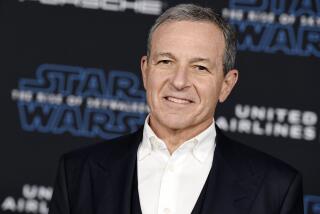PBS URGED TO PRESERVE ITS INDIVIDUALITY
- Share via
Public television stations must strive to remain distinctive despite market pressures to become more like independent television stations that buy syndicated commercial programming, PBS President Bruce L. Christensen said .
Christensen, in Redondo Beach Wednesday to speak with television critics and editors from around the country, said that PBS stations that seek to diversify by using syndicated programs of the type that routinely appear on independent commercial stations or cable TV channels (such as “Leave It to Beaver” or “Lassie”) “do themselves a disservice.”
He explained that PBS stations with limited budgets might eventually find themselves outbid for syndicated material, and in the meantime might have lost their cachet as the haven for alternative, public-TV fare.
Christensen conceded that cable networks such as Arts & Entertainment, Discovery and the Disney Channel present strong competition for PBS by offering the same sort of fine arts, educational and children’s programming that traditionally has been public television’s strong suit. But he said that he believes that PBS’ own in-house productions will differentiate PBS fare from cable offerings, provided that individual stations show their support for such programs.
He added that PBS has had to rethink its recent commitment to co-production with various cable networks in order to avoid diluting the uniqueness of PBS offerings by allowing them to be available on other programming outlets first (a problem that usually does not extend to co-ventures with foreign producers to be aired outside the United States).
“We want to see that what we’re doing with co-ventures is in our best interest,” he said.
Meanwhile, Christensen said public television continues to battle cable systems that bounce PBS programming to less desirable, high-numbered channels. He said that PBS’ best defense against this is to encourage public television viewers to put pressure on their local cable systems, as KCET Channel 28 supporters did recently in Southern California.
Although Christensen stressed the importance of PBS’ distinctive position in the viewing market, public television’s concern with being competitive will show in this season’s new programming, said Suzanne S. Weil, PBS’ senior vice president of programming.
“We’re not as predictable as we used to be,” she said, citing more comedy and lighter programming on the new schedule, including “Trying Times,” public television’s first original comedy anthology series (produced by KCET).
“It’s subtle, but it’s changing,” Weil said of the general tone of PBS programming.
Despite concern over the competition from cable, videocassette recorders and independent stations, Christensen noted that PBS has not experienced the same audience erosion as the networks, with a growth of 3% to 4% for the past several years. And last year’s subscribers provided $200 million in support versus about $145 million the previous year, he said.
Christensen took some heat during the discussion about an article in the current issue of TV Guide that attacks public television for bloated operational budgets and lack of creativity, among other things.
While conceding the the Corp. for Public Broadcasting had flaws in its corporate structure, he called the article inaccurate and a merely a rehash of the usual criticism about public broadcasting.
More to Read
The biggest entertainment stories
Get our big stories about Hollywood, film, television, music, arts, culture and more right in your inbox as soon as they publish.
You may occasionally receive promotional content from the Los Angeles Times.








